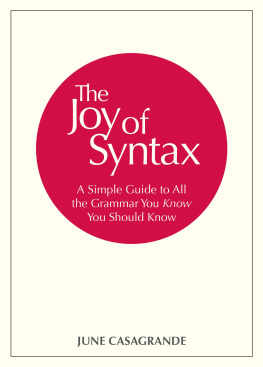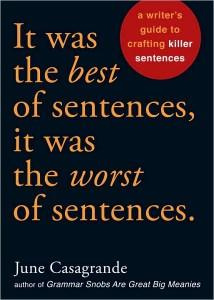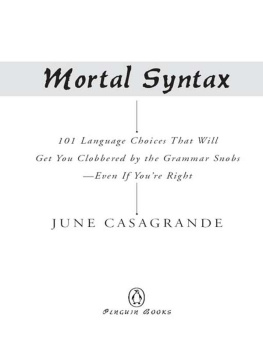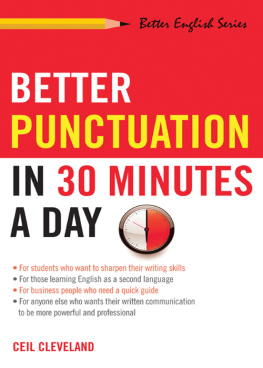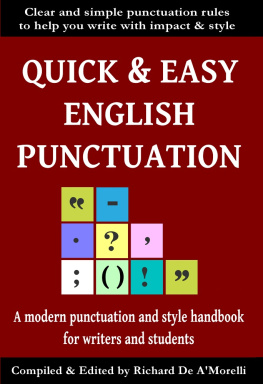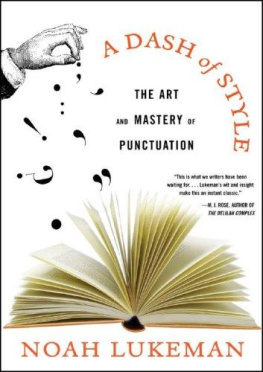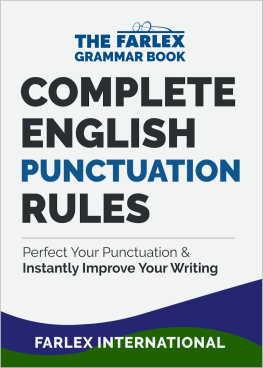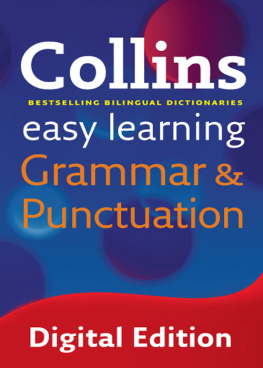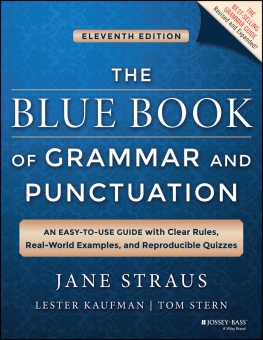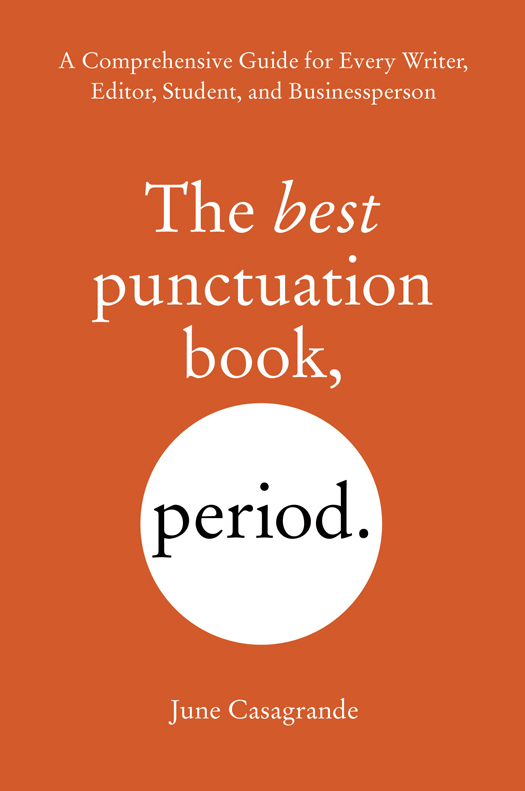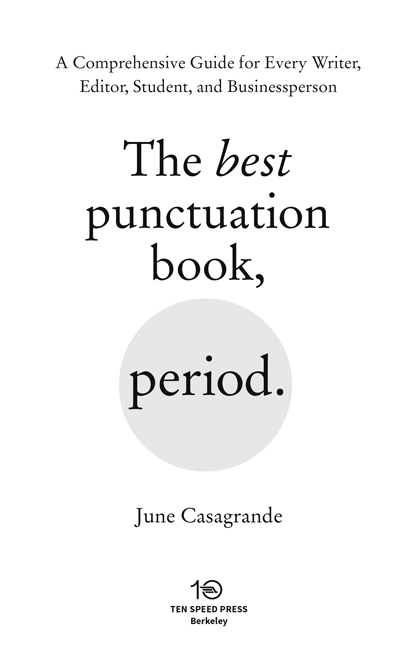Copyright 2014 by June Casagrande
All rights reserved.
Published in the United States by Ten Speed Press, an imprint of the Crown Publishing Group, a division of Random House LLC, a Penguin Random House Company, New York.
www.crownpublishing.com
www.tenspeed.com
Ten Speed Press and the Ten Speed Press colophon are registered trademarks of Random House LLC
Library of Congress Cataloging-in-Publication Data
Casagrande, June.
The best punctuation book, period : a comprehensive guide for every writer, editor, student, and businessperson / June Casagrande. First Edition.
pages cm
1. English languagePunctuationHandbooks, manuals, etc. 2. English languageGrammarHandbooks, manuals, etc. 3. English languageRhetoricHandbooks, manuals, etc. I. Title.
PE1450.C47 2014
428.23dc23
2013030260
Trade Paperback ISBN: 978-1-60774-493-1
eBook ISBN: 978-1-60774-494-8
v3.1
CONTENTS
INTRODUCTION: PUNCTUATION IS EASY, EXCEPT WHEN ITS NOT
Punctuate this:
In general the writer who did well in college earning As and Bs knows that a young aspiring middle grade novelist has an equally good reason to join the writers group because what it is is a line up of super creative people who for conscience sake treat it like a sub group of their audience to gauge the readers sensibilities and practice copy editing something they started in the 1960s and 70s because it was in the founders words far out
Did you put a comma after in general ? Did you put commas after writer, college, Bs , and group ? Did you put apostrophes in As , Bs, writers, conscience, readers, 70s , and founders ? Did you put hyphens in middle-grade, super-creative , and sub-group ? Did you put a dash before something ? Did you put quotation marks around far out but insert a period between the word out and the closing quotation mark?
If so, your passage probably looks a lot like this:
In general, the writer, who did well in college, earning As and Bs, knows that a young aspiring middle-grade novelist has an equally good reason to join the writers group, because what it is is a line up of super-creative people who for conscience sake treat it like a sub-group of their audience to gauge the readers sensibilities and practice copy editingsomething they started in the 1960s and 70s because it was, in the founders words, far out.
And you might think your polished, carefully punctuated passage is perfect. But youd be wrong.
The Los Angeles Times would disagree with your apostrophes in As and Bs . Per that newspaper, it should be As and Bs. The Chicago Manual of Style would disagree on different grounds: in that style, it should be As and Bs . Any book editor would swiftly change your copy editing to copyediting . Then theres your punctuation of far out. Most editors outside the United States would swap the places of your period and closing quotation mark.
It gets worse: your punctuation marks could even be creating factual errors. The writer, who did well in college refers to someone different than does the writer who did well in college . That comma changes the identity of the subject and even the number of people it represents because the writer who did well in college can refer to every student who did well in college.
Are you really sure that just one founder called it far out ? Or could those be the founders words? How sure are you that youre talking about the readers sensibilities and not the readers sensibilities ? Are you certain you want to leave line up as two unhyphenated words? Are you confident that an em dash is a better choice for setting off that final thought than parentheses or a colon? How would you explain your choice to leave a comma out of what it is is ?
How would you feel if, after leaving a comma out of young aspiring middle-grade novelist , you saw a highly respected publication use the same phrase except with a comma after young ?
On the surface, punctuation is simple stuff: a system of clear, well-documented rules we all learned in school. But when you sit down to write an article or a story or a business email or a blog post, suddenly its not so simple. One after another, situations arise in which the basic rules you thought you knew are no help at all. If you start looking for answers, it can get even more confusing. One of the most well-respected and influential style guides in the country will tell you to put just one comma in red, white and blue . But if you take that as gospel, youll be lost when you notice that nearly every book you pick up prefers to throw in another comma before the and , writing it red, white, and blue .
And heaven help you if you start paying attention to how professional editors use hyphens.
The truth is, punctuation can be very difficult. Professional writers dont know it all. Even professional editors look things up, debate them with colleagues, and are sometimes still left guessing.
No one knows everything there is to know about every punctuation mark, and no one is expected to. But that leaves any amateur or professional writer to ask: So what am I expected to know? Will I look stupid if I put a comma here or an apostrophe there? Or do even professional editors share my confusion on this matter?
A lot of people assume that theres a single correct answer for every punctuation conundrum. Either a comma belongs in a certain spot or it doesnt. Either the possessive of James is formed by adding an apostrophe plus an s , or its formed by adding the apostrophe alone.
The good news here is also the bad news: often theres more than one right answer. Whether to use a certain punctuation mark can be a matter of choicethe writers way of emphasizing his meaning, creating rhythm, or making the words more pleasing to the eye. Other times these questions boil down to a matter of stylethe kind with a capital S thats laid down by one of the publishing worlds official playbooks. Still other times, there is only one correct choice, and if you fail to choose it, you can inadvertently change your meaning.
The goal of this book is let you punctuate every sentence, even those that fall into the gray areas of punctuation rules or style differences, with complete confidence.
What Is Style?
In editing, style refers to the guidelines laid out by authorities like The Associated Press Stylebook, The Chicago Manual of Style , the Modern Language Association, the American Psychological Association, and any of the countless different in-house rules of specific publications and publishers. For example, large papers including the New York Times and the Los Angeles Times have their own in-house style guides. These style guides cover a broad range of issues, including grammar, word usage, and capitalization. But they also contain punctuation rules, and on these rules, the major guides often disagree. For example, for much of its history the New York Times put apostrophes in decades: 1970s, 1980s . Most other publications do not, clearly stating it should be 1970s, 1980s , and so on. The Los Angeles Times has its own rule for how to write African-American . Contrary to AP style and even the dictionary the newspaper follows, the Los Angeles Times dictates that its reporters write African American with no hyphen.
Book publishing often writes its own rules, too, and these can be even more specific than newspapers in-house guides. Though most book editing follows The Chicago Manual of Style , book copy editors regularly create style sheets designed to govern a single book. These style sheets document the copy editors decisions on highly specific matters of punctuation as well as spelling and word choicematters that may not be mentioned in the dictionary or the style guideto assure that theyre handled consistently throughout the book. For example, a copy editor has to make a judgment call about whether a compound like green farming procedures requires a hyphen, and then note it in the style sheet to make sure its handled the same way throughout the book. Similarly, a style sheet for a novel in George R. R. Martins Song of Ice and Fire series would probably note that the books use the variant spelling grey to the preferred American spelling of gray and that ser and pease are to be used in place of sir and peas .


